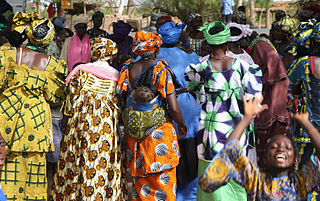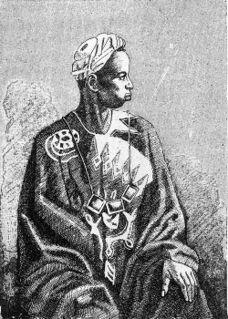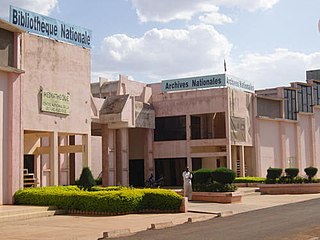 W
WThe culture of Mali derives from the shared experience, as a colonial and post-colonial polity, and the interaction of the numerous cultures which make up the Malian people. What is today the nation of Mali was united first in the medieval period as the Mali Empire. While the current state does not include areas in the southwest, and is expanded far to the east and northeast, the dominant roles of the Mandé peoples is shared by the modern Mali, and the empire from which its name originates from.
 W
WBògòlanfini or bogolan is a handmade Malian cotton fabric traditionally dyed with fermented mud. It has an important place in traditional Malian culture and has, more recently, become a symbol of Malian cultural identity. The cloth is exported worldwide for use in fashion, fine art and decoration.
 W
WA Chiwara is a ritual object representing an antelope, used by the Bambara ethnic group in Mali. The Chiwara initiation society uses Chiwara masks, as well as dances and rituals associated primarily with agriculture, to teach young Bamana men social values as well as agricultural techniques.
 W
WThe Festival International des Masques et des Arts, or FESTIMA, is a cultural festival celebrating traditional African masks held in Dédougou, Burkina Faso. Founded to help preserve traditional cultural practices in the modern age, FESTIMA features masks and traditions from several West African countries. It is currently held biennially in even-numbered years. The most recent edition, the fourteenth, was held from February 24 to March 3, 2018.
 W
WThe Great Mosque of Niono is an architecturally significant mosque located in the city of Niono, in the Ségou Region of southern Mali.
 W
WA griot is a West African historian, storyteller, praise singer, poet, or musician. The griot is a repository of oral tradition and is often seen as a leader due to their position as an advisor to royal personages. As a result of the former of these two functions, they are sometimes called a bard.
 W
WThe Ikelan are a caste within Tuareg society, who were at one time slaves or servile communities. While the Ikelan now speak the same language as the Tuareg nobles and share many customs, they are of assimilated Nilotic origin rather than of Berber heritage like the ethnic Tuareg. They also often live in communities separated from other castes.
 W
WMaghrebi script refers to a loosely related family of Arabic scripts that developed in the Maghreb, al-Andalus (Iberia), and Biled as-Sudan. Maghrebi script is influenced by Kufic letters, and is traditionally written with a pointed tip, producing a line of even thickness.
 W
WThe National Library of Mali is located in Bamako, Mali.
 W
WThe Palais de la culture Amadou Hampaté Ba is the national performing arts centre for Mali, located in the capitol Bamako. Founded in 1976, the PCAHB is a public establishment, supported by the state for the preservation of traditional means of artistic expression. It is directed by the Direction Nationale des Arts et de la Culture of Mali, an arm of the Ministry of Culture, and is home to a number of Malian national institutions, including the Mali Centre of the International Theatre Institute, the National Theatre, the National Orchestra, the National Ballet Company, and the National Institute of the Arts. The current Palace of Culture was constructed in 1996. It is named for the famed Malian novelist and national hero Amadou Hampaté Ba. Its current director is Madame Haïdara Aminata Sy, named March 2008.
 W
WRed Earth is a 2007 studio album by Dee Dee Bridgewater. It carries the subtitle "A Malian Journey" to celebrate and explore her African and Malian ancestry. The album brought her the seventh nomination for Best Jazz Vocal Album at the 2008 Grammy Awards. On Billboard's Top Jazz Album chart it reached Number 16.
 W
WThe Simo society is a secret society in West Africa also described as a "masked cult". It hails, according to a UNESCO report, from among either the Temne people or the Baga people at the time of the Mali Empire. The Susu people's political organization "assigned an important role to the Simo initiation society", and it "dominated" the organization of the Baga and the Landuma people.
 W
WThe talking drum is an hourglass-shaped drum from West Africa, whose pitch can be regulated to mimic the tone and prosody of human speech. It has two drumheads connected by leather tension cords, which allow the player to change the pitch of the drum by squeezing the cords between their arm and body.
 W
WTimbuktu Manuscripts is a blanket term for the large number of historically important manuscripts that have been preserved for centuries in private households in Timbuktu, Mali. The collections include manuscripts about art, medicine, philosophy, and science, as well as copies of the Quran. The number of manuscripts in the collections has been estimated as high as 700,000.
 W
WWassoulou is a cultural area and historical region in the Wassoulou River Valley of West Africa. It is home to about 160,000 people, and is also the native land of the Wassoulou genre of music.
 W
WWeddings in Mali involve various important customs and celebrations spread out through a number of days. Usually, the groom and the bride do not personally know the attendees that come to the wedding festivity, because Malian families tend to be very big due to polygamy. Therefore, most of the time it is very hard for one to know every member of his or her extended family. Thus weddings are a perfect occasion for all the extended family members of the couple to come for the big day. Wedding ceremonies in Bamako are a time when the community comes together to support the bride and groom's family. During this time food is given, and family from the village come to say goodbye to the bride-to-be and celebrate with the family.